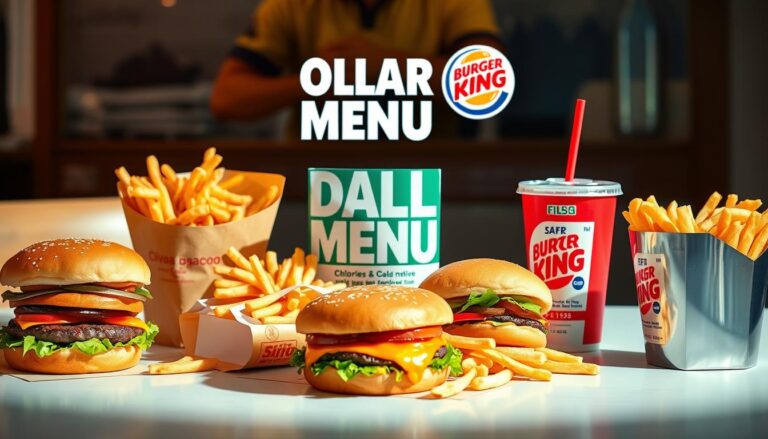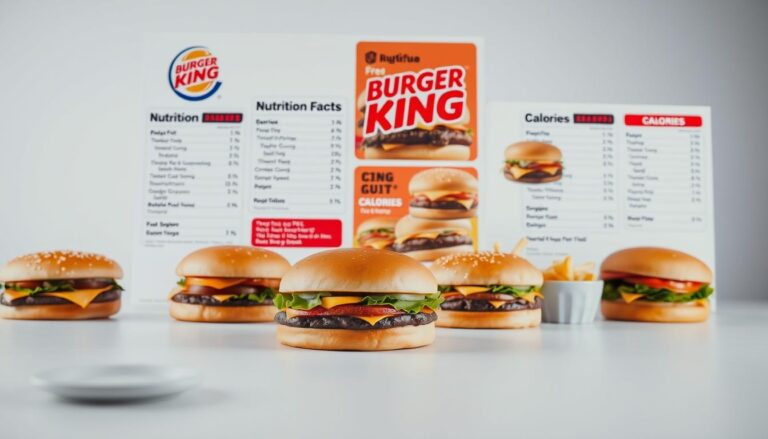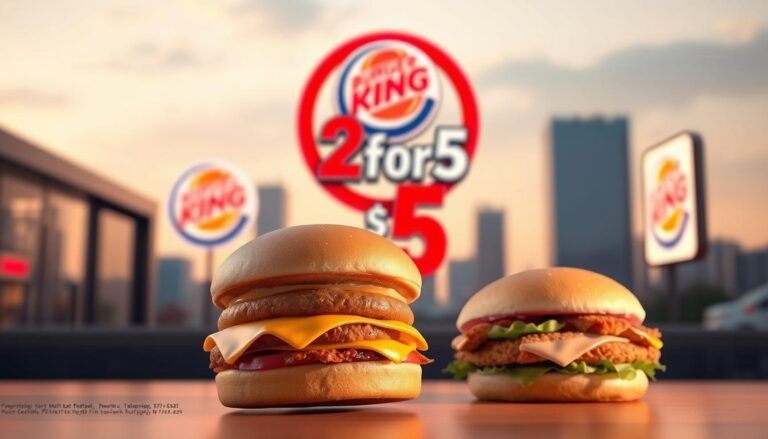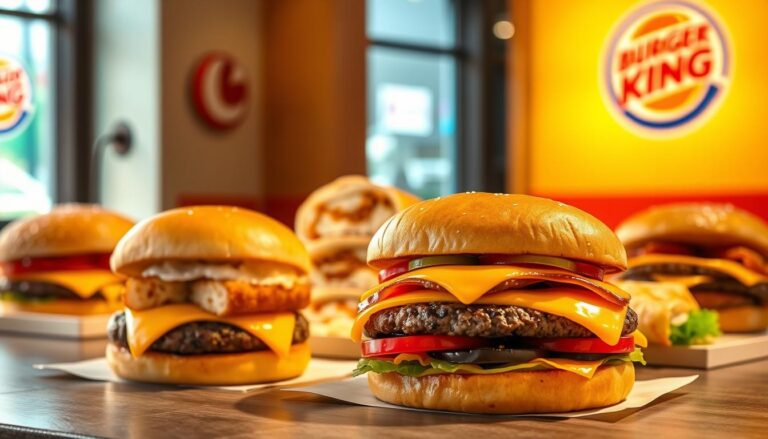Burger King Allergen Menu: Full List of Allergens
Burger King’s Allergen Menu clearly lists the 14 major allergens. This makes it easy to spot potential risks before ordering. The menu includes Milk, Eggs, Fish, Shellfish, Peanuts, Tree Nuts, Soy, Wheat, Mustard, Sesame, Celery, Lupin, Gluten, and Sulphur Dioxide. It also warns about possible cross-contact in the kitchen.
This guide helps you understand what to look for on the Burger King allergy chart. It covers both U.S. and U.K. menus. Burger King regularly updates its allergen data to help those with food intolerances or allergies make safer choices.
It’s important to know that the allergen listings cover a wide range of items. This includes recipes, sauces, bakery items, sides, drinks, and even limited-time offers. Menu items and their exact formulations can change by location. Always check www.bk.com before you go to confirm details.
The guide also explains the 14-allergen list used for reporting. It talks about the risks of cross-contact in open kitchens. It brings together information from Burger King U.S. and Burger King UK. It also references the company’s latest updates.
This article will help you quickly identify allergens in common menu items. It will highlight where Milk, Eggs, Wheat/Gluten, Soy, and Tree Nuts are often found. It will also warn about shared-equipment risks like broilers, toasters, and fryers. This way, you can plan your meals with more confidence.
Burger King Allergen Menu overview
This guide helps you understand the Burger King allergen chart. It explains how to use the chart to plan your meal. You’ll learn about the symbols and the legal allergens listed. This way, you can check items like the WHOPPER® or Chicken Royale® before ordering.
What the allergen table covers
The allergen table lists Burgers, Chicken, Breakfast, Sides, Desserts, Beverages, and retail-packaged items. It names specific products, like WHOPPER®, Bacon KING™, and Chicken Royale®. It also lists accessory items like cheese slices, sauces, and patties.
Dip pots and sauce sachets have allergen details on their packaging. Retail-packaged items like porridge and bottled juices have standard declarations. But, test items and limited-time offers might not be listed, and menus can differ by restaurant.
Explanation of symbols: Contains, May contain, May contain via shared equipment
Contains (●) marks allergens that are planned ingredients. May contain (◻) flags a risk of cross-contamination during manufacturing. May contain via shared equipment (°) signals possible cross-contact in the Burger King kitchen.
Fryer oil filtration, shared broiler/grill use, and toasters are common cross-contact vectors. The chart uses these symbols to help you understand the risk of food sensitivities for your order.
Legal list of 14 major allergens used in reporting
Allergen reporting follows a standard 14-item list. This list includes Milk, Eggs, Fish, Crustaceans/Molluscs, Peanuts, Tree Nuts, Soy, Wheat, Mustard, Sesame, Celery, Lupin, Gluten, and Sulphur Dioxide.
These categories appear consistently across Burger King allergen information. While the brand has controls like separate storage and cleaning, it cannot guarantee any product is completely free from an allergen. Customers with severe allergies should proceed with caution.
| Category | Example Items | Common Allergen Flags | Cross-contact Notes |
|---|---|---|---|
| Burgers | WHOPPER®, Bacon KING™ | Wheat, Milk, Soy, Sesame | Shared broiler, toasters, condiment stations (°) |
| Chicken | Chicken Royale®, Crispy Chicken Sandwich | Wheat, Egg, Milk, Soy | Shared fryers and broiler use (°) |
| Breakfast | Breakfast sandwiches, sausage patties | Egg, Milk, Wheat | Shared griddle and toaster equipment (°) |
| Sides & Fries | French fries, onion rings, hash browns | Wheat, Milk (seasoning) | Shared fryers; oil filtration reduces but does not remove risk (°) |
| Desserts & Shakes | Sundaes, shakes, pies | Milk, Egg, Wheat, Tree Nuts (varies) | Scooping tools and counters may cause cross-contact (°) |
| Beverages & Retail | Coffee drinks, bottled porridge, juices | Milk, Gluten (porridge), Sulphur Dioxide | Packaged labels carry supplier declarations; prepare for local variation |
Common allergens found across Burger King menu options
Many guests check ingredient lists before ordering. This guide helps you find where milk, wheat, soya, egg, and tree nuts are found. This way, you can manage Burger King dietary restrictions and food sensitivities better.
Milk and dairy
Milk is in cheese slices, milkshakes, sundaes, and bakery items like brownies and cones. Many sandwiches have cheese or milk sauces. Shakes and sundaes have milk, so those with dairy sensitivities should avoid them or ask for ingredient verification.
Wheat and gluten
Wheat is in almost all buns, breakfast pastries, and fried items. Buns are toasted in shared equipment, which increases cross-contact risk. Hash browns, pancakes, and French toast sticks may have gluten, depending on the region.
Soya, egg, and tree nuts
Soya is in some burger patties, sauces, and fryer oil blends in U.S. kitchens. Egg is in egg patties, mayonnaise sauces, and some bakery goods. Tree nuts are rare but can be in some items; always check labels.
| Menu Category | Milk & Dairy | Wheat & Gluten | Soya | Egg | Tree Nuts |
|---|---|---|---|---|---|
| Burgers | Cheese, sauce | Buns, toasted | Pattie binders, some sauces | Mayonnaise sauces | Rare; supplier may-contain |
| Chicken | Breadcrumbs, sauces | Breaded coatings, buns | Fryer oil blends | Some coatings, sandwiches | Uncommon; check LTO items |
| Breakfast | Eggs, cheese, milk in bakery | Biscuits, croissants, pancakes | Some patties, sauces | Egg patties and bakery | Possible in packaged sweets |
| Sides | Dips and dressings | Some fried items, batter | Fryer oil; seasoning blends | Dips containing mayo | Unlikely; check packaging |
| Desserts & Shakes | Shakes, sundaes, cones | Bakery items with flour | Ingredient blends in desserts | Certain bakery fillings | May-contain warnings on specials |
| Beverages | Milk-based drinks, coffee additions | Flavor syrups with gluten-based ingredients (rare) | Some flavored syrups | Egg not typical | Unlikely |
Use this matrix to compare categories when planning a meal. Customers managing Burger King food sensitivities or strict dietary restrictions should ask staff for local ingredient lists. Also, confirm any seasonal items before ordering.
Allergens in Burger King burgers and beef items
When you pick a Burger King burger, it’s good to know which ingredients might cause a reaction. Beef sandwiches like the WHOPPER®, BIG KING®, and others have similar allergens. Always check the labels and ask staff about where the ingredients come from if you have severe allergies.
The WHOPPER allergen information shows common allergens like milk, wheat, and soy. Cheese and cheese sauce add milk proteins. Buns are made of wheat and might have sesame seeds or traces of egg and milk.
Some patties and seasonings include soy as an ingredient.
WHOPPER®, BIG KING®, and other beef sandwich allergen patterns
Many beef sandwiches have milk, wheat/gluten, and soy in their ingredients. Some may have “may contain” warnings for egg, fish, or tree nuts. These warnings are due to shared equipment or co-manufacture.
Buns, cheese, bacon, and condiments as allergen sources
Buns are a big source of wheat and may have sesame. Toasting doesn’t remove allergens. American cheese and other slices have milk.
Bacon can introduce cross allergens. Ingredient panels might list preservatives that cause sensitivities.
Condiments like KING Sauce and ketchup vary by region. Mayonnaise often has egg. Some sauces have mustard or soy. Always check the Burger King allergy menu items for exact condiment profiles before ordering.
Cross-contact risks from broiler and shared toasters
The broiler cooks all beef patties and some breakfast items. This creates a risk of cross-contact between beef sandwiches and breakfast sausages. Customers with severe allergies should be careful.
All buns are toasted in the same toaster. This can transfer gluten, sesame, milk, or egg residues between items. If you need a bun-free option for gluten or sesame reasons, ask for no-toast preparation and confirm local kitchen practices.
| Item | Price | Calories | Vegan/Keto/Gluten-Free | Allergens |
|---|---|---|---|---|
| WHOPPER® | $4.19 | 657 | Keto: No · Vegan: No · Gluten-Free: No | Milk, Wheat/Gluten, Soy, Sesame (possible) |
| WHOPPER® with Cheese | $4.69 | 710 | Keto: No · Vegan: No · Gluten-Free: No | Milk, Wheat/Gluten, Soy, Sesame (possible) |
| Bacon KING™ | $5.49 | 1,150 | Keto: No · Vegan: No · Gluten-Free: No | Milk, Wheat/Gluten, Soy, Egg (condiment dependent), Sesame (possible) |
| Cheeseburger | $1.99 | 300 | Keto: No · Vegan: No · Gluten-Free: No | Milk, Wheat/Gluten, Soy, Sesame (possible) |
| BIG KING® | $3.99 | 530 | Keto: No · Vegan: No · Gluten-Free: No | Milk, Wheat/Gluten, Soy, Egg (may be in sauce), Sesame (possible) |
Allergens in chicken, fish, and poultry menu items
Burger King’s chicken and fish options have clear allergen flags and cross-contact risks. Wheat is found in most breaded items, milk in some coatings or cheeses, and soy in batter or oil. This section explains key items, kitchen practices, and fryer concerns to help you make safer choices.

Chicken Royale®, Crispy Chicken, and chicken nuggets allergen notes
Chicken Royale®, the Crispy Chicken Sandwich, and Chicken Nuggets often have wheat in their breading. Some recipes include milk in the coating or cheese. Soy may be in batter or through fryer oil contact.
Some items may have “may contain” warnings for eggs or tree nuts due to shared equipment or recipe variations. Small bones might be in poultry. Burger King suggests eating carefully and notes that bone removal is routine but not guaranteed.
Fish items and seafood cross-contact considerations
Fish items, like the KING Fish and Fish Finger Kids Meal, contain fish and wheat. Cross-contact with crustaceans or molluscs is possible in broad kitchen operations. The presence of other seafood allergens varies by region and shared preparation spaces.
Allergens in fish products can be increased by shared utensils, prep surfaces, and fryer filtration systems.
Shared fryer concerns and which items may be fried together
Fryer vats are grouped by product type, but oil moves through a shared filtration system. Oil blends include corn, canola, soy, and cottonseed oils in the U.S. This setup poses cross-contact risks for fish, shellfish, soy, and wheat.
Items that can be cooked in the same fryer system include Fish Filet, Pork Sausage, Crispy Chicken Patty, Chicken Nuggets, and more. Remember Burger King’s seafood allergen information and shared fryer details when ordering fries or battered items if you have a seafood sensitivity.
Dietary breakdown:
| Item | Price | Calories | Vegan/Keto/Gluten-Free Options | Allergens (Wheat, Milk, Soy, Fish) |
|---|---|---|---|---|
| Chicken Royale® | $4.99 | 430 | Not Vegan, Not Keto, Not Gluten-Free | Wheat: Yes; Milk: May contain; Soy: Possible; Fish: No |
| Crispy Chicken Sandwich | $5.49 | 500 | Not Vegan, Not Keto, Not Gluten-Free | Wheat: Yes; Milk: Yes (if cheese added); Soy: Possible; Fish: No |
| Chicken Nuggets (10 pc) | $3.99 | 420 | Not Vegan, Not Keto, Not Gluten-Free | Wheat: Yes; Milk: Possible; Soy: Yes; Fish: No |
| KING Fish | $4.29 | 370 | Not Vegan, Not Keto, Not Gluten-Free | Wheat: Yes; Milk: No; Soy: Possible; Fish: Yes |
| Chicken Fries | $2.99 | 280 | Not Vegan, Not Keto, Not Gluten-Free | Wheat: Yes; Milk: Possible; Soy: Yes; Fish: No |
Use this info alongside local allergen charts and staff guidance. For severe allergies, ask crew members about fryer practices and specific product builds before ordering.
Allergens in breakfast items and bakery products
Breakfast at Burger King has many items with egg, milk, and wheat. It’s important to check the ingredients and how they are made. This helps manage allergies to Burger King breakfast items.
Eggs are in folded egg patties and many sandwiches. Milk is in cheese, croissant layers, and pancake batter. Wheat is in buns, croissants, pancakes, and bakery goods.
Eggs, milk, and wheat in breakfast sandwiches and patties
Egg & Cheese CROISSAN’WICH® and Sausage, Egg & Cheese CROISSAN’WICH® have egg and wheat. Biscuits and croissants have wheat and may have milk. Pancake batter has wheat, milk, and egg.
Hash Browns might have wheat or milk cross-contact risk. Customers should know that most bakery items have at least one of the three main allergens.
Shared equipment used for breakfast sausage and beef patties (broiler)
BK’s broiler cooks beef patties and some breakfast sausage patties together. This means there’s a risk of cross-contact with proteins and allergens.
Guests with severe allergies should be careful with morning meats. The broiler notes in Burger King’s dietary restrictions guide warn about this risk.
Toaster and bun toasting cross-contact advisory
All buns are toasted in one shared toaster. Some buns have sesame, milk, or egg. Toasting different buns together can spread crumbs or residue.
If you can’t handle sesame, milk, or egg, avoid bun-based sandwiches. Ask for a non-toasted option if available. Check Burger King’s breakfast allergens and ask staff about local precautions.
| Item | Price | Calories | Vegan/Keto/Gluten-Free | Allergens |
|---|---|---|---|---|
| Egg & Cheese CROISSAN’WICH® | $2.99 | 300 | Not Vegan / Not Keto / Not Gluten-Free | Egg, Milk, Wheat; Shared Broiler; Shared Toaster |
| Sausage, Egg & Cheese CROISSAN’WICH® | $3.99 | 520 | Not Vegan / Not Keto / Not Gluten-Free | Egg, Milk, Wheat; Shared Broiler; Shared Toaster |
| Hash Browns | $1.49 | 150 | Not Vegan (may contain milk) / Not Keto / Not Gluten-Free | Wheat (may contain), Milk (possible cross-contact); Shared Fryer |
| Pancake Platter | $4.49 | 620 | Not Vegan / Not Keto / Not Gluten-Free | Egg, Milk, Wheat; Shared Griddle; Syrup may contain additives |
For the latest on Burger King’s bakery allergens and full lists, check in-store guides or the allergen chart. Staff can also confirm local menu and preparation practices for breakfast dietary restrictions.
Allergens in sides, salads, and kid’s meals
Knowing which sides and small plates carry common allergens helps you pick safer options. This guide explains fryer risks, salad ingredients, and King Jr. Meal items. So, you can make an informed choice before ordering.
French fries, hash browns, onion rings — shared fryer and oil ingredients
French fries and hash browns are often cooked in fryers that may also handle fish and breaded items. Fryer oil in the U.S. usually contains corn, canola, soy, or cottonseed oils. This creates cross-contact risk for people with soy or seed oil sensitivities.
Onion rings and some battered sides include wheat and milk in their batter. Regional recipes and “May Contain” flags vary by location. For strict avoidance of wheat or dairy, ask staff about local production practices.
Salad bases versus dressings: which contain egg or milk
Garden Side Salad bases are typically just greens and vegetables and do not include dressing by default. Dressings and added toppings are the main allergen sources.
Dressings such as Caesar or mayonnaise-based varieties can contain egg. Cheese toppings and mozzarella sticks add milk-derived allergens. The Chicken Garden Salad and Chicken Club Salad depend on whether the chicken is breaded or grilled and which dressing you choose.
Kid’s menu items (nuggets, apple slices, milk) and allergen labeling
King Jr. Meals commonly include Hamburger, Cheeseburger, Chicken Nuggets, Fat Free Milk, Low Fat Chocolate Milk, Mott’s Natural Applesauce, Capri Sun Apple Juice, and the PB&J Jamwich in some markets. Kid’s Nuggets contain wheat and milk and may be cooked in shared fryers.
PB&J Jamwich contains peanut butter in select regions. Packaged drinks and applesauce list allergens on product labels. Always check the product packaging and local allergen notices for Burger King kid’s menu allergen info.
| Item | Price (est.) | Calories | Vegan/Keto/Gluten-Free | Allergens |
|---|---|---|---|---|
| French Fries (small) | $1.99 | 320 | No/Vegan option depends/No | May contain soy (oil), cross-contact with fish/meat; wheat-free unless coated |
| Hash Browns | $1.49 | 150 | No/Not keto/No | May contain soy (oil); some recipes include wheat |
| Onion Rings | $2.49 | 260 | No/Not keto/No | Wheat, milk in batter; fried in shared fryer |
| Chicken Nuggets (5 pc) | $3.19 | 270 | No/Not keto/No | Wheat, milk; fried in shared fryer |
| Chicken Nuggets (Kids) | $2.49 (with meal) | 270 | No/Not keto/No | Wheat, milk; shared fryer cross-contact |
| Garden Side Salad | $2.99 | 40 | Yes/Yes/Yes (without topping) | Base—no major allergens; dressings/toppings vary |
| Chicken Garden Salad (grilled) | $5.49 | 220 | No/Depends/No | May contain soy (marinade), egg or milk in dressing, cross-contact |
| Chicken Garden Salad (breaded) | $5.99 | 380 | No/No/No | Wheat, milk in breading; dressing-dependent |
| Mozzarella Sticks | $3.79 | 310 | No/Not keto/No | Milk, wheat; fried in shared fryer |
| KING Jr. Hamburger Meal | $4.49 | 430 | No/Not keto/No | Wheat (bun); may contain sesame; side and drink depend on choice |
| KING Jr. Cheeseburger Meal | $4.99 | 520 | No/Not keto/No | Wheat, milk (cheese); bun and condiments may add allergens |
| King Jr. PB&J Jamwich Meal | $4.89 | 390 | No/Not keto/No | Peanut (in some regions), wheat; check packaging |
| Applesauce (Mott’s) | $0.99 | 50 | Yes/Yes/Yes | Generally free of top allergens; check label |
| Fat Free Milk (kid) | Included | 90 | No/No/No | Milk |
| Low Fat Chocolate Milk (kid) | Included | 150 | No/No/No | Milk; may contain soy in additives |
Use the Burger King salad allergen chart when choosing dressings or added cheese. The chart clarifies which dressings contain egg or milk and flags items with shared-equipment risk. For complete safety, check local disclosures and the official fryer & sides statements before ordering.
When evaluating Burger King sides allergens and Burger King kid’s menu allergen info, ask staff about regional variations and packaged product labels. That step reduces surprises and lets you enjoy a meal with more confidence.
Allergens in desserts, shakes, beverages, and sauces
Sweet treats and drinks at Burger King are popular, but they often have common allergens. Always read the labels and ask staff for help if you’re unsure. This guide helps you understand where milk, egg, and other allergens are found in desserts, shakes, beverages, and sauces.
Milk and egg are big concerns in sundaes, shakes, and baked goods. Vanilla Soft Serve, Mini Ice Cream, and the Ice Cream Cone all have milk. Classic shakes like Vanilla, Chocolate, and Strawberry, as well as the OREO® Shake and OREO® FUSION®, contain milk. Some baked desserts, like the Hot Chocolate Brownie, have both milk and egg.
Packaging gives quick clues about allergens. Dip pots and sauce sachets have allergen info on the lids or packets. Bottled juices and porridge have full allergen statements on their labels. These notes help confirm ingredients when you order.
Beverages can sometimes have dairy. Drinks like Latte, Cappuccino, Flat White, and Mocha have milk or milk-based options. Some places can make drinks with milk alternatives if asked. Most packaged sodas and bottled water don’t have the 14 major allergens, but bottled milk products do have dairy warnings.
Staff can check Burger King shakes allergen info and Burger King sauce allergen labeling for specific items. If you have severe allergies, ask for written ingredient info when possible. Always check the printed sachet or dip pot label before eating.
Below is a concise dietary breakdown covering popular dessert and beverage items. Prices and calories are approximate averages and may vary by location.
| Item | Price | Calories | Vegan / Keto / Gluten-Free | Allergens |
|---|---|---|---|---|
| OREO® Shake | $3.99 | 560 | Not Vegan / Not Keto / Contains Gluten | Milk, Wheat (oreo), Soy |
| Vanilla Soft Serve | $1.49 | 210 | Not Vegan / Not Keto / Not Gluten-Free | Milk |
| Chocolate Milkshake | $3.99 | 590 | Not Vegan / Not Keto / Not Gluten-Free | Milk, Soy |
| Hot Chocolate Brownie | $2.99 | 330 | Not Vegan / Not Keto / Contains Gluten | Milk, Egg, Wheat |
| Sundae (Chocolate) | $2.49 | 280 | Not Vegan / Not Keto / Not Gluten-Free | Milk |
| Latte (medium) | $3.59 | 190 | Not Vegan (unless plant milk used) / Not Keto | Milk |
| Cappuccino (medium) | $3.59 | 120 | Not Vegan (unless plant milk used) / Not Keto | Milk |
| Packaged Coca-Cola® (bottle) | $1.99 | 140 | Vegan / Not Keto | None of the 14 major allergens |
| Bottled Low-Fat Chocolate Milk | $1.79 | 150 | Not Vegan / Not Keto | Milk |
| Assorted Sauce Sachet (ketchup, mayo, BBQ) | $0.00–$0.50 | Varies | Depends on sauce | See Burger King sauce allergen labeling on packet (may include Egg, Milk, Mustard) |
Use this info along with on-pack labels and staff guidance. For quick checks, compare the dip pot lid or sauce sachet note with the menu’s allergen matrix. Always ask for ingredient details before eating if you’re unsure.
Burger King allergen information for customers with dietary restrictions
If you have food sensitivities, this guide helps you navigate Burger King’s dietary restrictions carefully. Always read labels and ask questions. Remember, allergen information can change by location and with new offers.
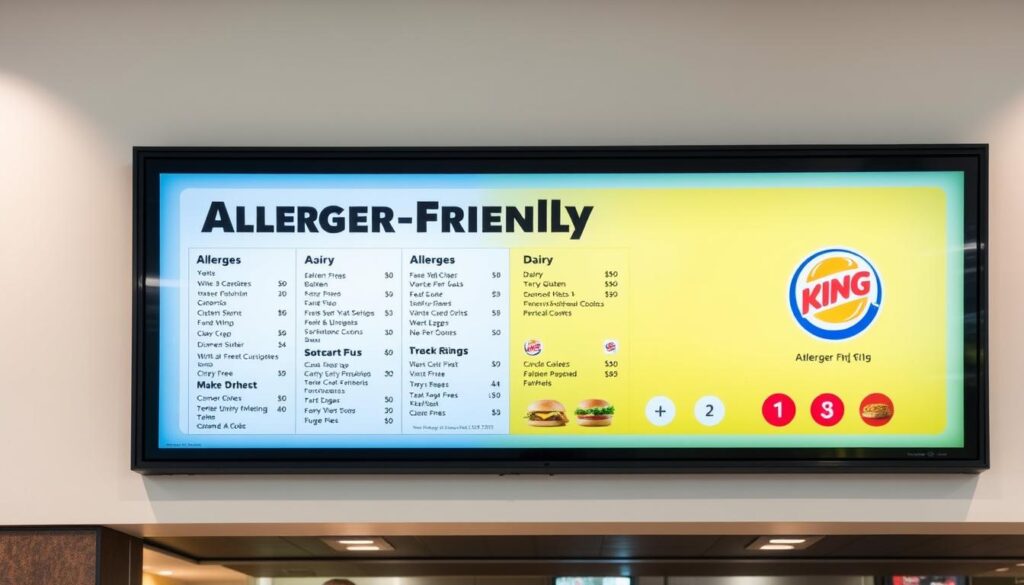
How to use the allergen chart and what to check before ordering
First, find the Burger King allergen chart for your item. Look for “Contains,” “May contain,” and “May contain via shared equipment” flags.
Check ingredient lists for items like WHOPPER®, Chicken Royale®, and OREO® Shake. This confirms specific allergens. Also, inspect dip pot lids and sauce sachets at pickup for labels.
Use the chart to pick safe menu choices. Note which sauces, buns, or toppings add allergens. If unsure, tell crew members about your allergy before ordering.
Limitations of kitchen controls and the risk for severe allergies
Burger King has controls like separate storage and dedicated utensils for some products. These steps reduce risk for many diners.
But, open kitchens, shared fryers, broilers, and toasters still pose cross-contact hazards. Severe allergies can react to trace amounts. The company can’t guarantee an allergen-free meal everywhere.
If you have a life-threatening allergy, talk to your healthcare professional before dining. Avoid toasted buns and fried items cooked in shared oil when your sensitivity is high.
Advice to verify local menu and LTO items on www.bk.com before visiting
Menu items and labeling vary by restaurant and region. Limited-time offers may not be in standard charts. Always check local ingredient and allergen details before you go.
Visit the online Burger King allergy-friendly menu and the latest allergen chart to confirm what’s available at your local restaurant.
Dietary checklist — quick actions to confirm safe choices:
- Check the online ingredient list for the specific item.
- Inspect sauce sachets and dip lids for on-the-spot allergen labels.
- Tell crew members about allergies and ask how items are prepared.
- Avoid toasted buns, shared fry items, and any product listed as “May contain.”
- Verify limited-time offers and local menu differences before ordering.
| Step | Action | Why it helps |
|---|---|---|
| 1 | Use the Burger King allergen chart online | Shows “Contains” vs “May contain” flags for each allergen and item |
| 2 | Inspect packaging and sauce lids at pickup | Confirms on-the-spot labeling and recent ingredient changes |
| 3 | Inform crew of allergies before ordering | Allows staff to advise on preparation and possible cross-contact |
| 4 | Avoid shared-fryer and toasted items when risk is high | Reduces chance of trace allergen exposure from equipment |
| 5 | Confirm local LTOs against the Burger King allergy-friendly menu | Prevents surprises from items not shown in national charts |
Conclusion
The Burger King allergen menu and allergy information show that they list the 14 major allergens. Milk, wheat/gluten, soy, and egg are the most common allergens. These are found in sandwiches, sides, desserts, and sauces.
Shared fryers, broilers, and toasters can cause cross-contact risks. So, it’s important to consider both ingredients and cooking methods when choosing.
Before you order, check the allergen chart and read labels on dips, sauces, and packaging. Visit www.bk.com for the latest menu, offers, and updates. Always tell staff about severe allergies and ask how items are prepared.
Use the dietary breakdown to plan safe choices. This includes Item, Price, Calories, and Allergens. You can find Burger King’s allergy-friendly menu items and enjoy safe, tasty options.
These tips come from Burger King’s allergen matrices and updates. They help you make safe choices at Burger King. Enjoy your meal with confidence and caution.


